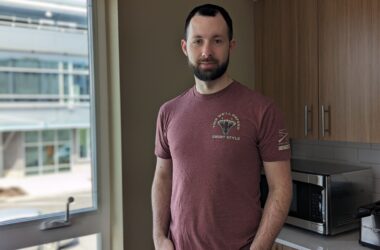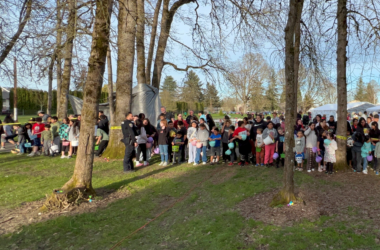 Hallman Elementary students gather during the school’s morning assembly in March 2019. (Fred Joe/Special to Salem Reporter)
Hallman Elementary students gather during the school’s morning assembly in March 2019. (Fred Joe/Special to Salem Reporter)
About 20 years ago, Jose Gonzalez was talking to a group of bilingual Salem residents. They pondered whether speaking Spanish would be a needed service for businesses in the future as their kids grew up speaking English.
The consensus among the group of professionals was that bilingual Spanish and English speakers were going to be needed less.
“We were wrong, way off,” said Gonzalez, a Salem city councilor who’s also president of Salem’s Latino Business Alliance.
He was reminded of the conversation hearing about the results of the 2020 Census, which showed a substantial growth in Salem’s Latino population. While the numbers don’t show how many new Salemites speak Spanish, Gonzalez sees the growth reflected in the demand for bilingual speakers in local businesses.
“Before, it was okay to say our receptionist was bilingual or one person on staff was bilingual. Now the need for bilingual services is spread deep and wide. It’s in almost every industry,” Gonzalez said
From 2010 to 2020, Salem added 20,000 residents, half of whom were Hispanic, according to 2020 Census data released last week.
In Salem, the Hispanic population grew by 10,000 people to 41,302, now making up about a quarter of the city. The city’s total population grew from 154,637 to 175,535.
Across Marion County, the Hispanic population grew from 76,594 to 95,740, making up 27% of the county. Marion County’s population grew from 315,335 to 345,920.
Polk County’s Hispanic population increased by 40% to 12,730.
Salem’s population changes based on race and ethnicity between 2010 and 2020 according to the latest Census data. (graphic by Saphara Harrell)
Reyna Lopez, executive director of Oregon farmworker union PCUN, said the numbers showing the growth in Salem and Marion County’s Latino populations echo what she’s observed over the past decade.
That includes more Latino-owned small businesses opening along Lancaster Avenue and in Woodburn, and the Salem-Keizer School District’s demographics shifting to the point where Latino students are now the largest racial or ethnic group in the district, about 44%.
“It was very affirming to what we already knew,” she said of the Census results.
Lopez said the numbers reflect outreach work by PCUN and other community organizations across Oregon that targeted immigrants, rural areas, non-English speaking people and explained the importance of filling out the Census. Fears that the Trump administration would use data collected to target immigrants made outreach more difficult, she said.
“All these community based organizations were engaged in a way I’d never seen with the Census count and I think that was a really big driver for just building trust,” she said.
RACE
The number of people identifying as two or more races more than doubled in both the city and county.
In Marion County the number of non-Hispanic people identifying as two races or more grew from 7,332 to 16,979. In Salem, it grew from 4,318 to 9,638.
That mirrors a nationwide trend showing America is becoming more diverse.
The New York Times reported the number of non-Hispanic Americans who identify as multiracial had jumped by 127% over the decade.
Part of the increase can be attributed to changes in the 2020 Census, where officials tried to more accurately capture the nuance in people’s racial backgrounds, the Times reported.
The Census Bureau has cautioned that comparisons of race and ethnicity between 2010 and 2020 should be made with caution because of the changes made to its latest survey.
In the last decade, Salem’s non-Hispanic, white population grew by 2,000 to 111,430.
In Marion County, the non-Hispanic, white population fell by 3,000 to 213,650.
Blacks, Asians, Native Hawaiians/ Pacific Islanders all saw population increases.
Salem’s Black population increased from 2,081 to 2,812. Asians increased from 4,134 to 5,446.
Native Hawaiian and Pacific Islanders increased by 62% to 2,293.
Marion County’s population changes based on race and ethnicity between 2010 and 2020. (Graphic by Saphara Harrell)
HOUSING
While Salem’s population grew by more than 20,000 people, housing has not kept pace.
In the last decade, the city added 6,135 housing units for a total of 67,411 units.
“It reflects what we know, that we have a big need for more housing,” said Eunice Kim, Salem’s long range planning manager.
Salem conducted a housing needs analysis in 2014 which projected the city would have a deficit of 2,900 multifamily housing units through 2035. That analysis assumed 2.55 people per household, so Salem would have needed to add 7,843 new housing units to accommodate its growth under that calculation.
The city is currently in the process of updating its comprehensive plan which seeks to add more flexibility in where multifamily housing can be built through zoning.
Rachel Alexander contributed reporting.
Contact reporter Saphara Harrell at 503-549-6250, [email protected].
JUST THE FACTS, FOR SALEM – We report on your community with care and depth, fairness and accuracy. Get local news that matters to you. Subscribe to Salem Reporter starting at $5 a month. Click I want to subscribe!









